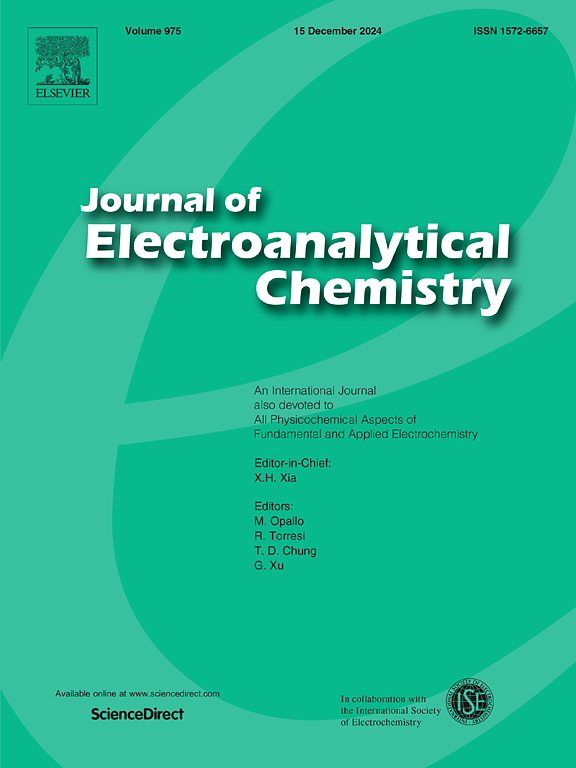为什么超级电容器多孔电极的阻抗模型/特性可以表述为单孔模式?
IF 4.1
3区 化学
Q1 CHEMISTRY, ANALYTICAL
引用次数: 0
摘要
文献中已有几种超级电容器多孔电极的多尺度阻抗模型。然而,有时多尺度阻抗模型在数学上过于复杂,难以用于超导材料的阻抗诊断。实际上,为了简化模型构建和便于理解,SCs多孔电极的阻抗模型及其相应特性更多地采用单孔模式,而不是双尺度模式。目前,对于上述退化存在一个疑问,即这种简单粗暴的双尺度阻抗模型近似是否合理可行?在严格的数值计算基础上,给出了双尺度阻抗模型转化为单孔模式的理论推导。在实际应用背景下,在0.01 Hz ~ 10 kHz整个感兴趣的频率范围内,数值计算得出了两个重要的认识:(i)单孔的阻抗模型可以退化为与纯电容串联的纯电阻;(ii)等效电容的阻抗比等效电阻的阻抗大三阶。基于以上认识,多孔电极的双尺度阻抗模型可以成功地转化为单孔模式。多孔电极的退化阻抗模型不仅在多尺度上包含丰富的信息,而且在数学上易于应用。本文章由计算机程序翻译,如有差异,请以英文原文为准。

Why impedance model/characteristics of porous electrodes for supercapacitors can be formulated into single pore mode?
There have existed several multi-scale impedance models for the porous electrode of supercapacitors (SCs) in literature. However, sometimes the multi-scale impedance model is too complex in mathematics to be easily used in the impedance diagnosis for SCs. Actually, impedance models and the corresponding characteristics of porous electrodes for SCs more often adopt single pore mode instead of the bi-scale mode to simplify the model construction and facilitate the understanding. Currently, there is one doubt for above degeneration, i.e., is this simple and rough approximation for the bi-scale impedance model reasonable and feasible? Based on the rigorous numerical calculations, this work gives a theoretical deduction for the bi-scale impedance model to be formulated into single pore mode. The numerical calculations yield two aspects of important understandings over the whole interested frequency range of 0.01 Hz ∼ 10 kHz under actual application background: (i) impedance model for the single pore can be degenerated into a pure resistor connected in series with a pure capacitor; and (ii) the impedance from the equivalent capacitor is three-order larger than that from the equivalent resistor. Based on the above understandings, the bi-scale impedance model for the porous electrode can be successfully formulated into single pore mode. The degenerated impedance model of the porous electrode not only contains rich information at the multiple scales, but is also mathematically easy to apply.
求助全文
通过发布文献求助,成功后即可免费获取论文全文。
去求助
来源期刊
CiteScore
7.80
自引率
6.70%
发文量
912
审稿时长
2.4 months
期刊介绍:
The Journal of Electroanalytical Chemistry is the foremost international journal devoted to the interdisciplinary subject of electrochemistry in all its aspects, theoretical as well as applied.
Electrochemistry is a wide ranging area that is in a state of continuous evolution. Rather than compiling a long list of topics covered by the Journal, the editors would like to draw particular attention to the key issues of novelty, topicality and quality. Papers should present new and interesting electrochemical science in a way that is accessible to the reader. The presentation and discussion should be at a level that is consistent with the international status of the Journal. Reports describing the application of well-established techniques to problems that are essentially technical will not be accepted. Similarly, papers that report observations but fail to provide adequate interpretation will be rejected by the Editors. Papers dealing with technical electrochemistry should be submitted to other specialist journals unless the authors can show that their work provides substantially new insights into electrochemical processes.

 求助内容:
求助内容: 应助结果提醒方式:
应助结果提醒方式:


